We landed on the riverbank near the mouth of a shallow stream and stepped gingerly ashore onto soft, ancient mud. Dissolved organic carbon samples collected last year by Polaris Project scientists from here at the bottom of the cliff were radiocarbon dated at 30,000 years old. We immediately began finding the bones of big animals that died sometime around then.
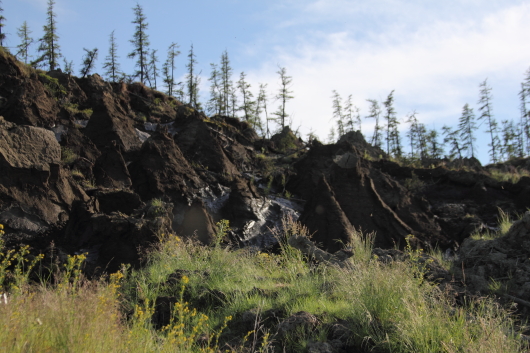
A striking landscape greeted us as we came ashore at Duvannyi Yar. The dramatic earthen cones are called baigerakhs, and they are what is left behind after an ice wedge melts away. © Becky Tachihara
“That is bison,” said Sergei Zimov. “This is horse, this I don’t know, that is rhinoceros, and that is baby mammoth tooth.”
We started trudging up the cliff, and straightaway Mantsa got stuck shin-deep in the mud. He crawled out of his boots (like alligator) onto harder ground to a chorus of Russian-language ridicule. The gist of it was that Mantsa, from the dry Genghis-Kahn steppes of the Kalmyk Republic, had never seen mud. I was glad it wasn’t me stuck in the mud; it might well have been; I don’t know all that much about mud myself. It was hard going, the ground full of holes and fallen trees hidden under stiff-leaved vegetation, but we attained the top without further incident.
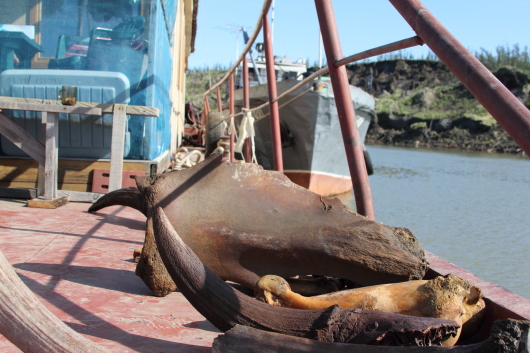
A growing collection of bones sits on the edge of the barge after Polaris members scavenged them from the soils of Duvannyi Yar. Among them is part of a baby mammoth’s jaw, miscellaneous vertebrae and a nearly intact bison skullcap, complete with horns. © Becky Tachihara
Geographical features as exotic as Duvannyi Yar, if any, are probably best absorbed from photographs by those not present to see it for themselves. For this, Becky’s fine images will serve, while I try to explain how Duvannyi Yar got that way. What we’re seeing here is an exposed, river-cut cross section of the permafrost that underlies all of the Kolyma lowlands. The bulk of it consists of fine sediment called Yedoma. That, like other permafrost words, originates from the Yakutian culture. But there is some debate among scientists who’ve adopted the terms as to the origin of Yedoma. Did it flow in from rivers (“alluvial”) or did it blow in as dust on the wind (“Aeolian”)? Or perhaps from a combination of both with long-decayed vegetable matter mixed in? It’s very fine stuff, almost grainless, that crumbles in your hand when dry and steals your boots when wet.
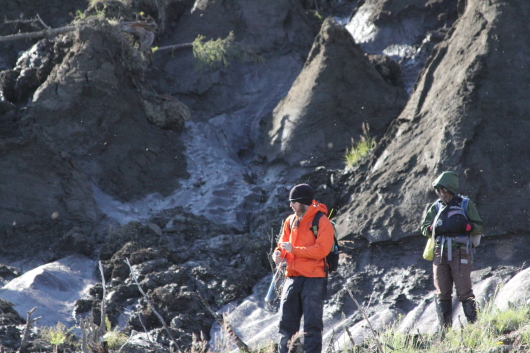
Sam and Ludda prepare to hike up over the cliffs looming above the river at Duvannyi Yar. © Becky Tachihara
But the weirdest, most distinctive features of Duvannyi Yar are those point-up conical structures of yedoma, like giant termite mounds, nearly contiguous on the cliff. Baigerakh (“by-ger-ak”) is the Yakutian/scientific term. They resulted from the action of ice. Eons ago water found its way into cracks in the ground and, over successive seasons of freeze and thaw, widened and deepened the openings with the widest part upslope. The ice acted like giant wedges driving downward into the yedoma. Indeed, they’re called ice wedges. Then as the cliff face eroded away from the river, the ice wedges were exposed and fell away or they simply melted. The yedoma into which the ice had wedged remained as cones—baigerakhs—with their sharp tops pointing upward. (In common usage by the Russians, “yedoma” refers not solely to the sediment, but to the entire structure as a unity, including the ice wedges.) A few ice wedges were still visible on the cliff, but the melting is happening rapidly. “When I was young man,” Sergey told me, “summer temperature often was minus five. It was common. Now over last ten years, it does not happen.” During the last week, the weather had been redolent of Southern California.
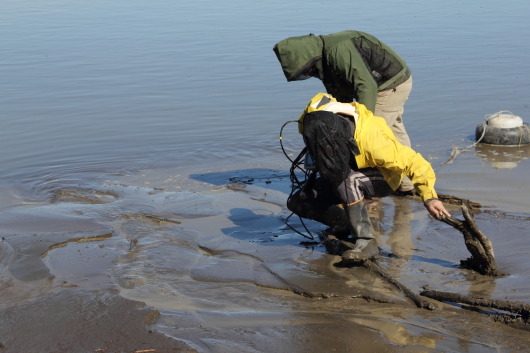
Eli and Paul build a pathway of driftwood out to the mouth of the mud stream running out of Duvannyi Yar and into the Kolyma. Without the driftwood, they would be sinking up to their knees in mud. © Becky Tachihara
In some places, the Duvannyi Yar cliffs bow visibly downward almost tangent with the shoreline. These are remnants of thermokarst lakes, ubiquitous features on the Kolyma floodplain. They’re formed when water fills natural depressions in the landscape. The lakes are relatively stable when they form on flat land. However, where they occur in proximity to the Duvannyi Yar cliffs, their existence is temporal—the cliffs are eroding at some five meters a year. Eventually, the erosion will breach the lakeshore, spilling its water into the Kolyma, leaving that bowed depression as a remnant.
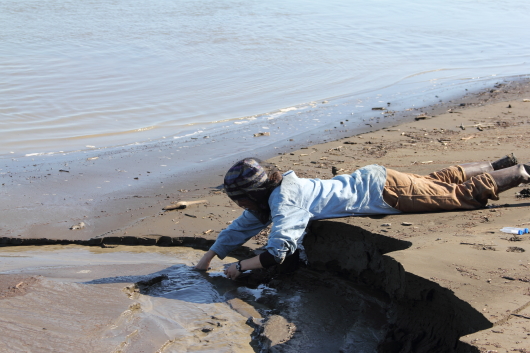
Laurel stretches out on her stomach to avoid sinking into the mud while she takes a sample from a little mud stream at Duvannyi Yar. © Becky Tachihara
“See here,” Sergei said, poking the forest floor at the crest of the cliff with his shovel. “Sphagnum moss and lichens. Grasses cannot grow in this, only trees. This was not always so. In Pleistocene times when climate was drier, this was vast grassland full with herbivores. Great bison, musk oxen, horses, rhinoceros, mammoths, caribou, and predators, wolves and lions. Twenty, thirty animals per square kilometer. This we know from bones. But then humans came onto land.”
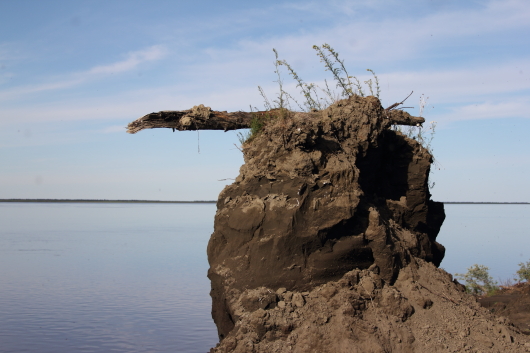
A log rests precariously atop a baigerakh at the edge of Duvannyi Yar, overlooking the Kolyma River. © Becky Tachihara
Sergei explained that the Pleistocene megafauna did not go extinct as a result of climatic stress; they survived the Ice Age as well as the shift to a much warmer climate. They were driven to extinction, he contends, by human predation. Successive waves of human hunters arrived for the rich pickings with ever more sophisticated weapons fashioned from bone (there is little rock in the region adequate for tool/weapon technology) and killed everything they could. One would suppose that a single mammoth or bison could feed a band of hunters for a long time, particularly in cold weather. But Sergey believes that they didn’t kill the herbivores exclusively for food, but also for fat to stoke cooking and warming fires, and sometimes “for fun.” Further, he makes a sociological step, contending that women played a conclusive if indirect role in megafauna extinction. “Women like warm hut,” he said, “to make children.” This led to further predation for fat. Also, a man’s virile hunting prowess impressed the women, which for obvious reasons encouraged increased predation. Those motives to hunt and kill led ultimately to extinction, which in turn led to a kind of negative environmental feedback.
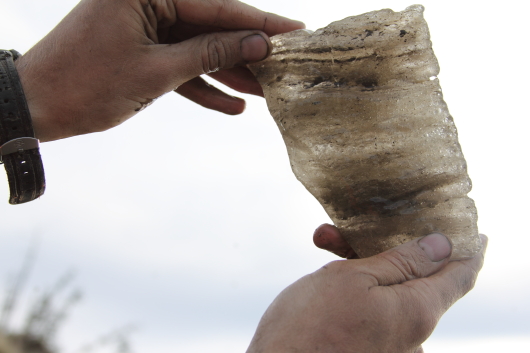
Sam holds up a piece of ice chipped off of an exposed ice wedge to look at its layers, which indicate the passage of time. © Becky Tachihara
The density of herbivores—denser, he believes, than today’s Serengeti—had sustained the steppe-like grassland environment. “See this—“ He knelt by an isolated patch of long grass and pulled up brown, dead grass. In the absence of herbivores, the previous season’s dead grass choked out new production. By that progression the grass died off as a direct result of the grass-eater’s human-induced extinction. The larch forest took over.
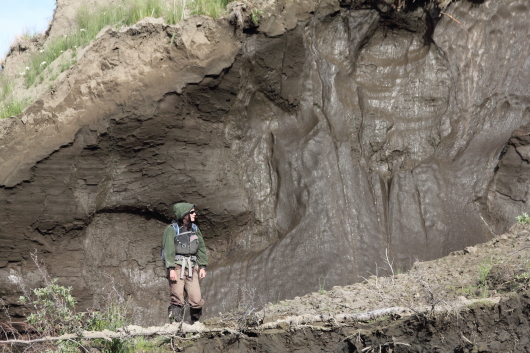
Ludda stands in front of one of Duvannyi Yar’s mammoth cliffs of ice and yedoma. (No pun intended, though Ludda did find a mammoth bone during her explorations.) © Becky Tachihara
Sergei led us through swarming mosquitoes past a thermokarst lake the size of a Manhattan block and by a switchback route down the cliff face to the nearly beach-less riverbank—to look for bones. They were everywhere, a Pleistocene charnel house. Sergei, Nastia, Kate, and Matt, collected leg bones, ball sockets, vertebra, teeth, and mandibles and tossed them to Max following along in the skiff. But Sergei Davidoff found the most spectacular artifacts, a bison skullcap with enormous horns still intact and a nearly intact baby mammoth jawbone complete with sad little teeth.
Back on the barge before lunch, I sat alone on the bow and peered at the Duvannyi Yar cliffs thinking about carbon and climate and bones—and their braided metaphorical connection. Once in unimaginable numbers fantastic animals roamed this region and flourished for eons across severe climatic extremes. Then they were gone. Why? Was it us, as Zimov contends, our magnificent capabilities to build, to invent and our darker but related tendencies to destroy? Once it was unthinkable that the permafrost could ever thaw; it is no longer. Once it was unthinkable that the wonderful works of our heads and hands could breed the seeds of our own destruction. But there it was—billions of tons of ancient carbon, the latent possibility of human misery, waiting for the works of man and their exhaust fumes to release it into the atmosphere….
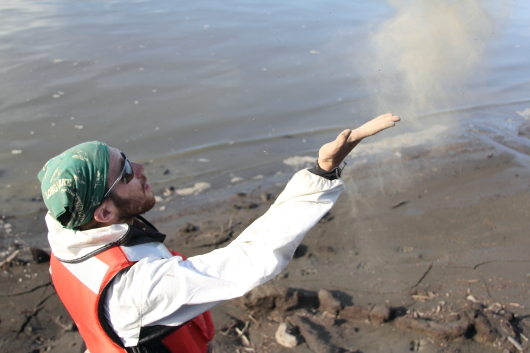
Sam tosses a handful of dust from Duvannyi Yar into the air. When the yedoma soil dries out, it becomes a very fine dust that can be carried by the wind…or by anyone who walks through it, since it gets into absolutely everything. © Becky Tachihara
No, relinquish the melancholy view, at least until after lunch. Students and PIs were coming aboard laughing at their own mosquito bites and laughing with Mantsa, who’d gotten stuck thrice more in the mud, as they unpacked more bones onto the deck.
Jorien’s boat came alongside after her morning sampling dissolved organic carbon in that thermokarst lake. “So what did you learn in your walk?” she asked smiling.
“That it was the women’s fault.”




Comments(2)-
Anita Hunt says
May 23, 2013 at 12:21 amI am just learning about Sergey Zimov and his experiment in returning the tundra to a “mammoth ecosystem”. I am fascinated by the idea that so many millions of large animals could have been hunted to extinction (or possibly herded away from an area long enough for a change in fauna causing a food shortage) but wouldn’t there be a human fossil record with as big a presence as the rest of the animals? Has there been evidence in the animal bones of husbandry? I would like to know more.